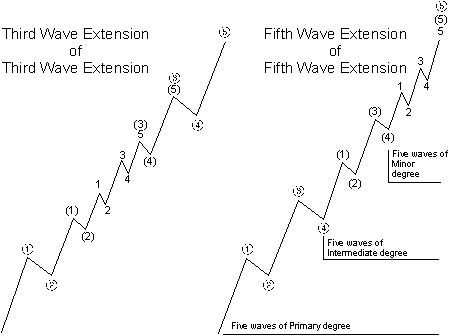Extension
Most impulses contain what Elliott called an extension. Extensions are elongated impulses with exaggerated subdivisions. The vast majority of impulse waves do contain an extension in one and only one of their three actionary subwaves. At times, the subdivisions of an extended wave are nearly the same amplitude and duration as the other four waves of the larger impulse, giving a total count of nine waves of similar size rather than the normal count of "five" for the sequence. In a nine-wave sequence, it is occasionally difficult to say which wave extended. However, it is usually irrelevant anyway, since under the Elliott system, a count of nine and a count of five have the same technical significance. The diagrams in Figure 1-5, illustrating extensions, will clarify this point.

Figure 1-5
The fact that extensions typically occur in only one actionary subwave provides a useful guide to the expected lengths of upcoming waves. For instance, if the first and third waves are of about equal length, the fifth wave will likely be a protracted surge. (In waves below Primary degree, a developing fifth wave extension will be confirmed by new high volume, as described in Lesson 13 under "Volume.") Conversely, if wave three extends, the fifth should be simply constructed and resemble wave one.
In the stock market, the most commonly extended wave is wave 3. This fact is of particular importance to real time wave interpretation when considered in conjunction with two of the rules of impulse waves: that wave 3 is never the shortest actionary wave, and that wave 4 may not overlap wave 1. To clarify, let us assume two situations involving an improper middle wave, as illustrated in Figures 1-6 and 1-7.

Figure 1-6 Figure 1-7 Figure 1-8
In Figure 1-6, wave 4 overlaps the top of wave 1. In Figure 1-7, wave 3 is shorter than wave 1 and shorter than wave 5. According to the rules, neither is an acceptable labeling. Once the apparent wave 3 is proved unacceptable, it must be relabeled in some way that isacceptable. In fact, it is almost always to be labeled as shown in Figure 1-8, implying an extended wave (3) in the making. Do not hesitate to get into the habit of labeling the early stages of a third wave extension. The exercise will prove highly rewarding, as you will understand from the discussion under Wave Personality in Lesson 14. Figure 1-8 is perhaps the single most useful guide to real time impulse wave counting in this course.
Extensions may also occur within extensions. In the stock market, the third wave of an extended third wave is typically an extension as well, producing a profile such as shown in Figure 1-9. Figure 1-10 illustrates a fifth wave extension of a fifth wave extension. Extended fifths are fairly uncommon except in bull markets in commodities covered in Lesson 28.

Figure 1-9 Figure 1-10
END OF PART 2.



